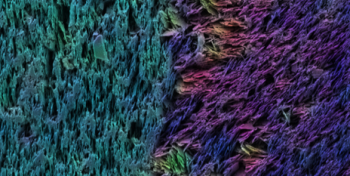A novel technique is being developed that makes it possible to imitate the fine and complex structure of seashells, teeth and other biological composite materials in order to mimic their hardness.
 A false colour electron microscope image of a tooth cross section. (Photo: Hortense Le Ferrand/ETH Zürich)
A false colour electron microscope image of a tooth cross section. (Photo: Hortense Le Ferrand/ETH Zürich)
The technique is being developed by a team of material researchers at ETH and will allow the development of artificial materials that share similar hardness and toughness of natural materials. The study has been published in the specialist journal Nature Materials.
Teeth and seashells are some of the most durable structures in nature. These characteristics can be attributed to their unique fine structure. The structures contain multiple layers of micro-platelets that are fused together and arranged in a similar direction in each individual layer.
Whilst material scientists can use existing techniques to mimic nacre, the substance that shells consist of, it is difficult to produce a material that could mimic the structural complexity of a complete seashell.
The new production process developed by the ETH research team produces material that imitates real shells almost perfectly. Led by André Studart, Professor of Complex Materials, the researchers applied their method to develop a hard and multi-layered material. For the first time, the team was able to produce different layers of micro-platelets in a complex arrangement multi-layer arrangement with different orientations in each layer. The researchers have dubbed this procedure as magnetically assisted slip casting (MASC).
The wonderful thing about our new procedure is that it builds on a 100-year-old technique and combines it with modern material research -Tobias Niebel, ETH
Initially, the scientists developed a plaster cast that was used as a mould. A suspension of aluminium oxide platelets was poured into this mould, and the pores present in the mould gradually absorbed the suspension’s liquid, allowing the material to become hard and solid from the outside in.
During the casting process, the researchers applied a magnetic field to produce a uniform layer-like structure, and consequently, altered its orientation at standard intervals. The ceramic platelets aligned to the magnetic field when the material was liquid, but the same platelets retained their direction when the material turned solid. Such a process results in materials that show strong similarity to their natural counterparts like tooth enamel.
Our technique is similar to 3D printing, but 10 times faster and much more cost-effective.
- Florian Bouville, ETH
In order to show the promising application of the MASC method, an artificial tooth with a similar microstructure of a natural tooth was produced. The artificial tooth’s surface was as structurally complex and hard as the natural tooth enamel.
Doctoral student Hortense Le Ferrand, who is also the co-author of the study, worked with her colleagues to make a plaster cast mould of a wisdom tooth and then filled it with a suspension comprising glass nanoparticles and aluminium oxide platelets as mortar. The researchers then used a magnet to arrange the platelets in a perpendicular direction to the object’s surface.
As soon as the first layer was dry, a second suspension was poured into the mould, but this suspension lacked glass particles. With the help of the magnet, the second layer containing aluminium oxide platelets was horizontally aligned to the tooth’s surface. Subsequently, the dual-layered structure was fired at 1600°C to harden the material. This is referred to as sintering process.
The researchers then used a synthetic monomer to fill in the remaining pores, and this monomer polymerised subsequently. The team was happy with the experiments outcome and claimed both the process and the resulting material hold immense potential in dentistry.
The profile of hardness and toughness obtained from the artificial tooth corresponds exactly with that of a natural tooth.
- Prof. André Studart, ETH
One part of the MASC technique, that is the orientation and magnetisation of the ceramic platelets, has been patented. In addition to producing complex biomimetic materials, the novel production process can even be used in other promising applications. For example, instead of using the standard aluminium oxide platelets, copper platelets could possibly be utilised in electronics.
“The base substances and the orientation of the platelets can be combined as required, which rapidly and easily makes a wide range of different material types with varying properties feasible”
- Prof. André Studart, ETH